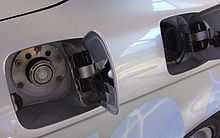Hydrogen internal combustion engine vehicle

A hydrogen internal combustion engine vehicle (HICEV) is a type of hydrogen vehicle using an internal combustion engine.[1] Hydrogen internal combustion engine vehicles are different from hydrogen fuel cell vehicles (which use hydrogen + oxygen rather than hydrogen + air); the hydrogen internal combustion engine is simply a modified version of the traditional gasoline-powered internal combustion engine.[2]
History
Francois Isaac de Rivaz designed in 1806 the De Rivaz engine, the first internal combustion engine, which ran on a hydrogen/oxygen mixture.[3] Étienne Lenoir produced the Hippomobile in 1863. Paul Dieges patented in 1970 a modification to internal combustion engines which allowed a gasoline-powered engine to run on hydrogen.[4]
Mazda has developed Wankel engines that burn hydrogen. The advantage of using ICE (internal combustion engine) such as wankel and piston engines is that the cost of retooling for production is much lower. Existing-technology ICE can still be used to solve those problems where fuel cells are not a viable solution as yet, for example in cold-weather applications.
Recently, BMW tested a supercar named the BMW Hydrogen 7, powered by a hydrogen ICE, which achieved 301 km/h (187 mph) in tests. At least two of these concepts have been manufactured.
HICE forklift trucks have been demonstrated [5] based on converted diesel internal combustion engines with direct injection.[6]
Alset GmbH developed a hybrid hydrogen systems that allows vehicle to use petrol and hydrogen fuels individually or at the same time with an internal combustion engine. This technology was used with Aston Martin Rapide S during the 24 Hours Nürburgring race. The Rapide S was the first vehicle to finish the race with hydrogen technology.[7]
Low emissions
The combustion of hydrogen with oxygen produces water as its only product:
- 2H2 + O2 → 2H2O
of high temperature combustion fuels, such as kerosene, gasoline, or natural gas, with air can produce oxides of nitrogen, known as NOx emissions. Although these are only produced in small quantities, research has shown that the oxides of nitrogen are about 310 times more harmful as a greenhouse gas than carbon dioxide.[8] Tuning a hydrogen engine in 1976 to produce the greatest amount of emissions possible resulted in emissions comparable with consumer operated gasoline engines from 1976. [9]
- H2 + O2 + N2 → H2O + NOx
Adaptation of existing engines
The differences between a hydrogen ICE and a traditional gasoline engine include hardened valves and valve seats, stronger connecting rods, non-platinum tipped spark plugs, a higher voltage ignition coil, fuel injectors designed for a gas instead of a liquid, larger crankshaft damper, stronger head gasket material, modified (for supercharger) intake manifold, positive pressure supercharger, and a high temperature engine oil. All modifications would amount to about one point five times (1.5) the current cost of a gasoline engine.[10] These hydrogen engines burn fuel in the same manner that gasoline engines do.
The power output of a direct injected hydrogen engine vehicle is 20% more than for a gasoline engine vehicle and 42% more than a hydrogen engine vehicle using a carburetor.[11]
See also
- Hydrogen fuel enhancement
- Liquid nitrogen vehicle
- List of hydrogen internal combustion engine vehicles
- Timeline of hydrogen technologies
References
- ↑ INL-Hydrogen internal combustion engine vehicles
- ↑ Workings of hydrogen ICE
- ↑ Eckermann, Erik (2001). World History of the Automobile. Warrendale, PA: Society of Automotive Engineers. ISBN 0-7680-0800-X.
- ↑ US 3844262
- ↑ Linde X39
- ↑ HyICE
- ↑ de Paula, Matthew. "Aston Martin Favors Hydrogen Over Hybrids, At Least For Now". Forbes. Forbes Publishing.
- ↑ http://www.epa.gov/nitrousoxide/scientific.html
- ↑ P.C.T. De Boera, W.J. McLeana and H.S. Homana (1976). "Performance and emissions of hydrogen fueled internal combustion engines". International Journal of Hydrogen Energy 1 (2): 153–172. doi:10.1016/0360-3199(76)90068-9.
- ↑ Converting of gasoline ICE to hydrogen ICE
- ↑ Hydrogen use in internal combustion engines